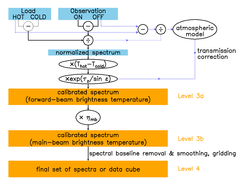SOFIA Data Processing

Fig. 1 - Data processing scheme for GREAT spectra. The blue boxes represent steps involving the FITS raw data, using the kalibrate program from the KOSMA package (Guan et al. 2012). The atmospheric model employs the AM atmospheric model (Paine 2019). The orange boxes describe the steps carried out in the CLASS software which is a part of the GILDAS package from IRAM.
Processing and calibration of airborne far-infrared spectra
The upGreat arrays and the four-color receiver 4Great are versatile instruments for high-resolution spectroscopy from sub-millimeter to far-infrared frequencies. Their potential, however, is fully explored only after careful consideration of the impact of telluric features in the data, and their compensation by a dedicated calibration. Despite the high flight altitude of SOFIA (38 to 45 kft), these features arise from residual water vapor in the stratosphere, and also from the absorption by dry constituents (mainly ozone). Narrow features arise from CO and atomic oxygen in the mesosphere. A broad pseudo-continuum absorption is induced by collisions between N2 and O2.
We provide the resulting atmospheric transmission throughout the tuning range of GREAT’s instrument suite for a flight altitude of 43 kft, 40° elevation, and a 10μm column of precipitable water vapor (i.e., for good, yet frequently encountered conditions). The data processing steps required to obtain a validated science product are schematically summarized in Fig. 1. A good transmission correction is also required for the determination of the coupling efficiencies of the individual mixers, and of the widths of their main beams. These parameters are frequently determined towards suitable planets, out of which Mars is our primary calibrator, with a well-modeled thermal emission (Lellouch & Amri 2006).
References
-
Guan, X. 2012, Astron.Astrophys. 542, L4.
-
Paine, S., 2019, SMA Memo #152 version 11.0.
GREAT data processing liaisons
- Rebeca Aladro
- Denise Riquelme
- Helmut Wiesemeyer
